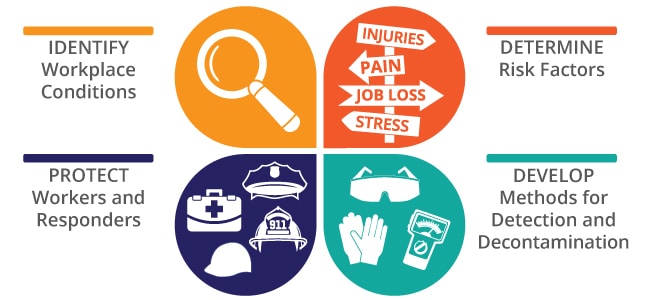Research on Opioids in the Workplace
The epidemic of opioid overdose deaths in the United States continues. The crisis impacts workers and communities across the nation. NIOSH and other public health agencies are conducting research to understand risk factors for use and potential misuse.
NIOSH Framework

By considering the “lifecycle” of opioid use from precursors in the workplace, to use conditions, to containment and decontamination, to strategic responses, NIOSH researchers and practitioners can offer unique recommendations targeted at workers and employers facing this crisis together. Policies, programs, and practices that address the conditions of work should be considered to protect workers and advance their health and well-being related to opioid exposure, use, and potential misuse. Search for NIOSH and NIOSH-funded publications on this topic here.
- Work-related exposures as risk factors for opioid use
- Chronic medical conditions as risk factors for opioid use
- Overutilization of opioids in physician prescribing in:
- Employee health services,
- Employer health plans,
- Workers’ compensation medical care.
- Opioid use as a contributor to workplace injuries and decreased productivity
- Workforce education about risks of opioid use disorder (OUD)
- Fitness-for-duty and impairment evaluation
- Workplace drug testing
- Availability of medical assisted treatment (MAT) for OUD
- Integration of opioid-affected workers back into the workplace
- Reasonable accommodation policy; and
- Return-to-work policy
Field Investigations
The NIOSH Health Hazard Evaluation Program has been working to better understand work-related exposures and potential health risks among emergency responders and other workers impacted by the opioid crisis. Below are some examples of Health Hazard Evaluation Reports from different settings.
Health Hazard Evaluation Reports
- (2021) Occupational exposure to opioids in a city police department
- (2021) Occupational exposures to opioids, mental health symptoms, exposure to traumatic events, and job stress in a city fire department
- (2020) Occupational exposures to illicit drugs at controlled substances laboratories
- (2020) Occupational exposures to illicit drugs at forensic sciences laboratories
- (2020) Occupational exposures to illicit drugs during an emergency medical services response
- (2019) Evaluation of Occupational Exposures to Opioids, Mental Health Symptoms, Exposure to Traumatic Events, and Job Stress in a City Fire Department
- (2019) Potential unintentional illicit drug exposure at a county jail
